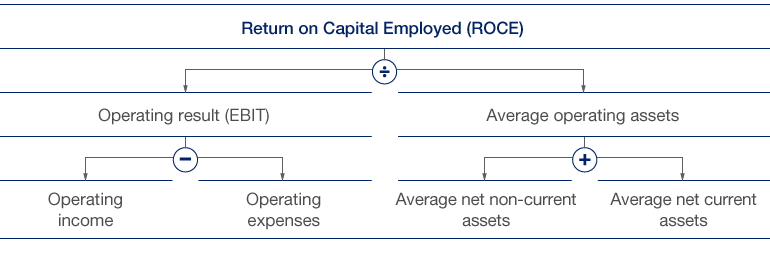Corporate and Value Management
HHLA’s primary financial objectives include the long-term, sustainable growth of its enterprise value. HHLA uses a Group-wide value management system for the planning, management and monitoring of its commercial activities. No changes were made to this system in the 2017 financial year.
Financial Performance Indicators
The key performance measures for operations used by the HHLA Group are the operating result (EBIT) and the average operating assets (capital employed). EBIT and capital expenditure as key drivers of capital employed are the main intra-year and short-term performance measures. Return on capital employed (ROCE) is calculated for the measurement of long-term, value-oriented performance and is also used to determine the annual value added. The HHLA Group calculates ROCE as a ratio of the operating result (EBIT) and the average operating assets used.
Value Management
ROCE – defining parameters and influential factors

Commercial activities are generally regarded as value-generating if ROCE exceeds the cost of capital and they make a positive value contribution. Such capital costs correspond to the weighted average of equity costs and the cost of borrowed capital. As in the previous year, HHLA used a weighted average cost of capital of 8.5 % before tax to calculate value growth at Group level in the 2017 financial year. This minimum interest rate reflects the Executive Board’s assessment of a medium- to long-term rate of return arising from a balanced relationship between equity and borrowed capital. This approach avoids short-term fluctuations in interest rates on the capital markets that may distort the information provided by the value management system.
The HHLA Group succeeded in increasing its operating result (EBIT) significantly in the 2017 financial year. EBIT rose by 5.6 % year-on-year to € 173.2 million (previous year: € 164.0 million). see also Group Performance With average operating assets virtually unchanged at € 1,321.2 million (previous year: € 1,317.6 million), the return on capital employed was up 0.7 percentage points on the prior-year figure of 13.1 %. The minimum ROCE of 8.5 % was therefore comfortably exceeded again – by 4.6 percentage points – in the 2017 financial year. The HHLA Group generated a positive value added of € 60.9 million in the reporting period (previous year: € 52.0 million).
in € million |
2017 |
2016 |
Change |
|||||
|
||||||||
Operating income |
1,296.4 |
1,241.9 |
4.4 % |
|||||
Operating expenses |
- 1,123.2 |
- 1,077.9 |
4.2 % |
|||||
EBIT |
173.2 |
164.0 |
5.6 % |
|||||
Ø Net non-current assets |
1,217.4 |
1,211.1 |
0.5 % |
|||||
Ø Net current assets |
103.8 |
106.5 |
- 2.6 % |
|||||
Ø Operating assets |
1,321.2 |
1,317.6 |
0.3 % |
|||||
ROCE in % |
13.1 |
12.4 |
0.7 pp |
|||||
Capital costs before tax1 in % |
8.5 |
8.5 |
0.0 pp |
|||||
Capital costs before tax |
112.3 |
112.0 |
0.3 % |
|||||
Value added in % |
4.6 |
3.9 |
0.7 pp |
|||||
Value added |
60.9 |
52.0 |
17.1 % |
|||||
Non-Financial Performance Indicators
The main non-financial performance indicators are container throughput and container transport volumes. In addition to the continuous dialogue that HHLA maintains with its customers, the company makes extensive use of macroeconomic forecasts as early indicators for volume trends and its operating activities. These include the anticipated development of gross domestic product for important trading partners and the subsequent estimates for foreign trade and import/export flows, as well as for container traffic on relevant routes and changes in the correlation between gross domestic product and containerised trading volumes.
Earnings before interest and taxes.
Average net non-current assets (intangible assets, property, plant and equipment, investment property) + average net current assets (inventories + trade receivables – trade liabilities).
EBIT / Average Operating Assets.
Production value – intermediate inputs (cost of materials, depreciation and amortisation, and other operating expenses); the value added generated is shared between the HHLA Group’s stakeholders, such as employees, shareholders, lenders and the local community.
EBIT / Average Operating Assets.
Expenses associated with the use of funds as equity or borrowed capital.
Earnings before interest and taxes.